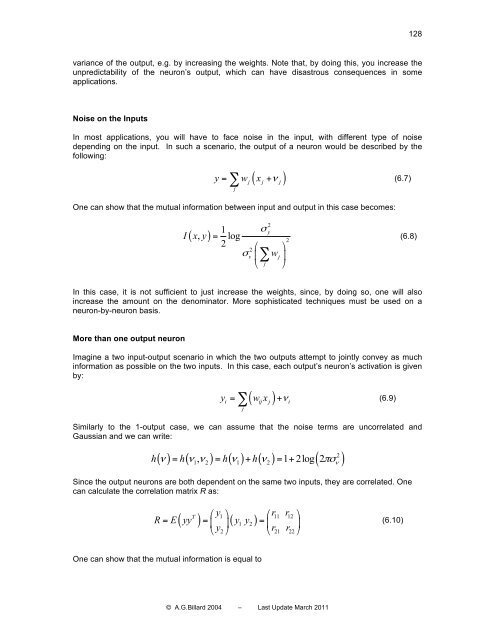MACHINE LEARNING TECHNIQUES - LASA
MACHINE LEARNING TECHNIQUES - LASA
MACHINE LEARNING TECHNIQUES - LASA
You also want an ePaper? Increase the reach of your titles
YUMPU automatically turns print PDFs into web optimized ePapers that Google loves.
128<br />
variance of the output, e.g. by increasing the weights. Note that, by doing this, you increase the<br />
unpredictability of the neuron’s output, which can have disastrous consequences in some<br />
applications.<br />
Noise on the Inputs<br />
In most applications, you will have to face noise in the input, with different type of noise<br />
depending on the input. In such a scenario, the output of a neuron would be described by the<br />
following:<br />
( )<br />
∑ j j j<br />
(6.7)<br />
j<br />
y = w x + ν<br />
One can show that the mutual information between input and output in this case becomes:<br />
2<br />
1 σ<br />
y<br />
I( x, y)<br />
= log<br />
2 ⎛⎛ ⎞⎞<br />
2<br />
σ<br />
v ⎜⎜∑<br />
wj⎟⎟<br />
⎝⎝ j ⎠⎠<br />
2<br />
(6.8)<br />
In this case, it is not sufficient to just increase the weights, since, by doing so, one will also<br />
increase the amount on the denominator. More sophisticated techniques must be used on a<br />
neuron-by-neuron basis.<br />
More than one output neuron<br />
Imagine a two input-output scenario in which the two outputs attempt to jointly convey as much<br />
information as possible on the two inputs. In this case, each output’s neuron’s activation is given<br />
by:<br />
( )<br />
∑ (6.9)<br />
y = w x + ν<br />
i ij j i<br />
j<br />
Similarly to the 1-output case, we can assume that the noise terms are uncorrelated and<br />
Gaussian and we can write:<br />
2<br />
( ν) = ( ν1, ν2) = ( ν1) + ( ν2) = 1+<br />
2log( 2πσ<br />
)<br />
h h h h<br />
ν<br />
Since the output neurons are both dependent on the same two inputs, they are correlated. One<br />
can calculate the correlation matrix R as:<br />
T<br />
⎛⎛y1 ⎞⎞ ⎛⎛r11 r12<br />
⎞⎞<br />
R= E( yy ) = ⎜⎜ ⎟⎟( y1 y2)<br />
= ⎜⎜ ⎟⎟<br />
y r r<br />
⎝⎝ 2⎠⎠ ⎝⎝ 21 22⎠⎠<br />
(6.10)<br />
One can show that the mutual information is equal to<br />
© A.G.Billard 2004 – Last Update March 2011

















